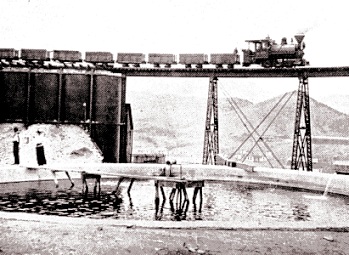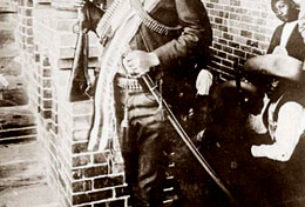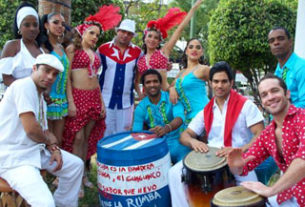Did You Know…?
November 7, 2007, marks the centenary of the death of Jesús García, the “Hero of Nacozari.”
The small town of Nacozari occupies a valley nestled in the foothills of the Western Sierra Madre (Sierra Madre Occidental) in the state of Sonora.
A hundred years ago this month, a young locomotive driver had to make a desperate decision: save his own life or try to save the lives of hundreds in his home town? Choosing the latter, he drove his dynamite-laden train away from the town but it finally exploded, killing him instantly. He was only 50 meters from safety. Just 50 meters further, and he could have abandoned the locomotive to its fate and jumped off the burning train to save his own skin.

(Detail of photo in Lewis W.
Douglas Collection, U. of Arizona)
His actions saved the town. Jesús García became a national hero. In his honor, November 7 is celebrated each year as Día del Ferrocarrilero (Day of the Railroad Worker).
The Background
By the end of the nineteenth century, Nacozari (the name means “abundance of prickly pears”) was a lively frontier town of about 5,000 people. A worldwide copper boom promised to be the town’s path to future wealth. Copper was needed for engines, motors, power plants, telephones, telegraph, pipes, rods and wire; demand was rising rapidly. Workers flocked in.
In 1895, Nacozari’s copper mines were owned by Moctezuma Copper Corporation, a subsidiary of Phelps Dodge. The following year, an important copper reserve was discovered nearby at Pilares. The company enlarged the town, building homes, stores, workshops, warehouses, furnaces and ore concentrators. All the supplies had to be brought in by mule train; most items came from Arizona or California. Ore was packed out of the mines, also by mules.
In 1899, the company built its own 8-kilometer-long narrow gauge railway from the mine at Pilares to Nacozari, for easier transport of ore to its concentrators. The elevation difference along this line is considerable, more than 600 meters (2,000 feet) from mine to town. Following concentration, the ore was taken to Douglas, Arizona, for smelting. These exports of ore became much easier in 1904 when a standard gauge railway line from Agua Prieta was extended to Nacozari.
Jesús García had been born Nov 13, 1883 in Hermosillo, Sonora. His mother moved with her eight children to Nacozari in 1898. García started work with the company railroad as a waterboy, quickly winning promotions to switch man, brakeman, fireman, and finally, by the age of twenty, to maquinista (engine driver). His work ethic was much appreciated by his employers. In 1904 they paid for García and seven colleagues to attend the World Fair in St. Louis, Missouri.
García drove locomotive number 2, transporting mineral ore and supplies between the loading yards in the town and the mine. The hazards faced by locomotive drivers included stray donkeys wandering onto the line, saboteurs tearing up the rails, and brake failures. In October 1907, García had managed to halt a train whose brakes had failed by reversing the wheels and dumping lots of sand on the line. The train finally ground to a halt only four meters from the end of the line.
García was a popular young man and engaged to María de Jesús Soqui. He serenaded her regularly, hiring the best local bands each time, and is reported to have done so on the night of Wednesday November 6, 1907.
The events of November 7, 1907
The following day, García was working as usual, and had several return trips scheduled to the mine. The mining company had three locomotives, all made by Porter of Pittsburgh. García operated a 0-6-0 locomotive built to order in 1901. The engines relied on wood for fuel and had to carry copious supplies of water and also sand (to increase the friction between rails and wheels).

(Photo in Douglas Collection, Tucson)
When García arrived for work, he was told that the train’s usual conductor (a German named Biel) had been admitted to hospital, so he would have to manage without him. By mid-day, García had completed two trips down from the mine with dozens of loaded ore cars. While other workers tended the engine and loaded the cars for the next trip, García had lunch at his mother’s house. Neighbors later confirmed that his mother shared her premonition of doom with him as they ate.
Just after 2 p.m., García set off again towards the mine. Locomotive number 2 was pulling several cars, the front two of which were open cars containing 70 boxes of dynamite, detonators and fuses. This was strictly against company regulations which stated that dynamite must be carried only in the rear cars. Other cars that day contained bales of hay. As they pulled out of the lower yard, stray sparks from the train’s chimney stack were blown back onto the first cars, causing a box of dynamite to begin smoking. Railway workers aboard the train desperately tried to douse the smoke, but their efforts failed, and the box caught fire.
García realized that if the train exploded near the lower yard, the resulting detonations of the company’s dynamite stores and gas tanks would almost certainly destroy most of Nacozari. He also realized that if he jumped from the train, it might run out of steam and roll backwards towards the town before exploding. He ordered everyone else off the train and opened the throttle wide, hoping to put a small ridge between him and the town, and perhaps reach Camp 6, a secondary loading area en route to the mine. If only he could pass Camp 6, he must have thought, he could safey leap from the train and the train would continue on into uninhabited wilderness.
By 2:20 p.m., García had driven the train six kilometers out of the town and was entering Camp 6 when the cars exploded. García was killed instantly by the massive blast. He died barely a week before his 24th birthday. At least 12 bystanders were also killed in the resulting carnage. Amazingly, the engine remained on the tracks; it was later sold to the Mereci Southern Railroad of Arizona.
The blast was heard up to 16 kilometers (10 miles) away. It shattered the glass in many of Nacozari’s buildings. Twisted metal was hurled through the air, to rain down several kilometers away.
But at least García’s quick thinking and brave actions had saved the main part of town. Within days, he was being hailed as a hero.
Hero of Nacozari
Two years after the accident, the town unveiled a permanent memorial to Jesús García, the Hero of Nacozari. Sadly, his fiancée did not live to see this; she died broken-hearted less than a year after García. On November 9, the state congress decreed that Nacozari would henceforth be known as Nacozari de García. García was awarded, posthumously, the American Cross of Honor.
Ten years after the train explosion, García’s ashes were reinterred close to his monument in Nacozari. In 1944, the federal government declared that the National Day of the Railroad Worker would be celebrated every November 7.
Jesús García became a national hero, after whom numerous streets, schools, bridges and parks have been named. There are monuments to him in many towns, including Hermosillo (the Héroe de Nacozari Stadium was home to the Coyotes de Sonora football team), Mexico City, Zacatecas, Veracruz, Tapachula, Guadalajara, Mazatlán, Naco, Aguascalientes, Ciudad Obregón, Empalme, San Luis Potosí and Tierra Blanca, as well as in other countries both near (Cuba, Guatemala) and far (United Kingdom, Germany).
English language song (ballad) about Jesús García
Many songs have been written in Spanish about the bravery of Jesús García (see below). The only known tribute to Jesús García written and sung in English is by Dolan Ellis (see comments below), a Grammy award-winning folk singer who was a member of “The New Christy Minstrels.” This song is featured on Ellis’ album “A Sense of Place.” Ellis has served as Arizona’s Official State Balladeer since 1966.
Jesús García (Dolan Ellis)
I’ll sing you the story of old Nacozari
that’s a town down in old Mexico
where the big mines of copper
dumped ore in the hopper
to load on the trains down below.
Well Jesús García was an engineer
oh, how he loved his train so
He kept it polished and shined
it was the pride of the line
Jesús was the star of the show.
Hey!
Hey! Jesús García.
You rode that train ’round the bin
Hey!
Hey! Jesús García
wherever that we go
We’ll tell them, amigo
you died a hero my friend.
Well, his little engine’ta
that he loved so sweet’a
had a hole in its sparkerer store
and as it puffed out the smokestack
the sparks they would fly back
as he chugged down the track
with its ore.
Though he asked for it fixed
somehow it got mixed
and continued to spray sparks galore
like red fiery rain
blowing back on the train
that carried the rich copper ore.
Well, fate can be fickle
as an old wooden nickel
Lady Luck can just… “whizz”, slip away
So, it did happen
while Jesús was napping
when they hooked up his train on that day.
Well, the dynamite car
which should be hitched up far
and way back to the end of the train
somehow instead it got hitched up ahead
behind the engine with the red fiery rain.
Hey!
Hey! Jesús García.
You rode that train ’round the bin
Hey!
Hey! Jesús García
wherever that we go
We’ll tell them, amigo
you died a hero my friend.
With his hand on the throttle
and his old water bottle
Jesús started that train up the hill
and sparks started flying
and men started crying
The dynamite is on fire!
We’ll be killed!
He heard a curse and a shout
we can’t put’er out!
If she blows, there goes the town and the mill.
Jesús instantly knew
what he needed to do
and he prayed for the nerve and the will.
With his train all in flame
he called out Jesus’ name
as the driver wheel turned round’n round
and he ordered the men
to jump off in the wind
as he herded that bomb out of town.
With the set of his jaw
and iron in his craw
he herded that train up the hill.
And when the dynamite blew
the town folk all knew
that Jesús had just paid the bill.
Hey!
Hey! Jesús García.
You rode that train ’round the bin
Hey!
Hey! Jesús García
wherever that we go
We’ll tell them, amigo
you died a hero my friend.
Most folks today
in their own hurried way
never heard of Jesús and his train
and they don’t give a damn
’bout this engineer man
but that don’t mean he died in vain.
Though his life was cut short
he had more to report
to his maker than most of us here.
So, when you see a train pass
say: Salud! Lift your glass
Give Jesús García a cheer.
Hey!
Hey! Jesús García.
You rode that train ’round the bin
Hey!
Hey! Jesús García
wherever that we go
We’ll tell them, amigo
you died a hero my friend.
Wherever that we go
We’ll tell them, amigo
you died a hero my friend.
So, here’s to
Jesúuus Garcíiiiaaa.
¡Salud!
(Words reproduced by kind permission of Dolan Ellis)
Spanish language song (corrido) about Jesús García
Of the popular songs or corridos written about Jesús García, the best known is Máquina 501. The composer of this corrido took a little poetic license with the engine number. As we have seen, García drove locomotive number 2; 501 was the number of the last locomotive ever operated by the mining company. When it was eventually retired to Nacozari’s main square, it was renamed the Jesús García.
Corrido de la Máquina 501
Máquina quinientos uno,
la que corrió por Sonora,
por eso los garroteros
el que no suspira, llora.
El fogonero le dice:
“Jesús, vámonos apeando,
mira que el carro de atrás
ya se nos viene quemando.”
Era un domingo, señores,
como a las tres de la tarde,
estaba Jesús García
acariciando a su madre.
Jesús García le contesta:
“Yo pienso muy diferente,
yo no quiero ser la causa
de que muera tanta gente.”
Dentro de pocos momentos:
“madre tengo que partir,
del tren se escucha el silbato,
se acerca mi porvenir.”
Le dio vuelta a su vapor,
porque era de cuesta arriba,
y antes de llegar al seis
allí terminó su vida.
Cuando llegó a la estación
un tren ya estaba silbando
y un carro de dinamita
ya se estaba quemando.
Desde ese día inolvidable
tú te has ganado la cruz,
tú te has ganado las palmas,
eres un héroe Jesús.
Garcia’s brave actions were turned into a movie El Héroe de Nacozari (1935), directed by Guillermo Calles, and have been the subject of several books, including Kate Tuthill’s award-winning “Hero of Nacozari”.
The Moctezuma Copper Co. suspended its operations in Nacozari in 1949, but the discovery in 1968 of new copper reserves 20 miles south east of the town has led to a revival. Mexicana de Cobre, a state-run company, built the infrastructure for open-cast mining which began in 1980. In 1988, the mines were bought by a group of investors from Mexico, Canada and Europe. Nacozari de García has had more than its fair share of economic ups and downs, but remains a pleasant mid-sized town. The 2005 inter-census count puts Nacozari’s population at 10,090. The town is still sustained largely by copper mining and cattle ranching.
Getting There
Nacozari is on Highway 17, about 250 kilometers (155 miles) northeast of Hermosillo and 100 kilometers (65 miles) south of Douglas, Arizona.
Main Sources:
- Don Dedora and Bob Robles. Goodbye García Adiós: the true and powerful story of one of Mexico’s authentic heroes. Northland Press. 1976.
This great bilingual book is well researched, with excellent photos and a glossary. - Peter Laux. Famous Mexicans on their Stamps: Jesús García, The Hero of Nacozari. Edited by Michael D. Roberts.
Note:
This article is the basis for Chapter 21 of Mexican Kaleidoscope: myths, mysteries and mystique (Sombrero Books, 2016), reviewed by Rita Pomade for MexConnect here: detailed review.
Text © Copyright 2007 by Tony Burton. All rights reserved.




My name is Dolan Ellis. I am “Arizona’s Official State Balladeer” for over 55 years, by appointment of 13 consecutive Arizona Governors. I was also an original member of the famous 1960’s folk singing group, “The New Christy Minstrels”. We earned both a Grammy award and a gold record with our music in 1962. I thought maybe you might like to know that I have also written a ballad or corrido about Jesus Garcia. I wrote it over 15 years ago. It is, of course, written and sung in English and is included on my, “Sense of Place” album. I believe that my song, “The Ballad of Jesus Garcia”, is the only English-speaking song ever written about this Mexican hero, and it has made tens of thousands of non-Hispanic people, (as well as many Mexican/American people), aware of Nacozari, Jesus Garcia, and his historic and heroic act of 1907.
I would be honored to share my song with whomever, and for whatever you might like to use the song.
Hi Dolan, Thanks for your informative comments about Jesús García. We are deeply honored that you reached out to us. Congratulations on both your folk singing career, and on composing “The Ballad of Jesus Garcia.”What a wonderful tribute to Jesús! With your permission (and due credit), we would like to add a short piece to our site about your song, including the words and a link to your YouTube recording of it.
Mister Ellis, as a Mexican I’m very greatlful that a non-Mexican author and singer of your stature took the time and his talent to compose a song about one of our Mexican heroes, specially one that even many Mexicans don’t know much about. Thank you for doing that. God bless and hope you get recognized for this in some special way.
Mister Ellis, I took the liberty of translating the song into Spanish for my non-English speaker friends.
If you would like to post the translation in this website please reach out to me and I’ll send the translation over.
Thank you.